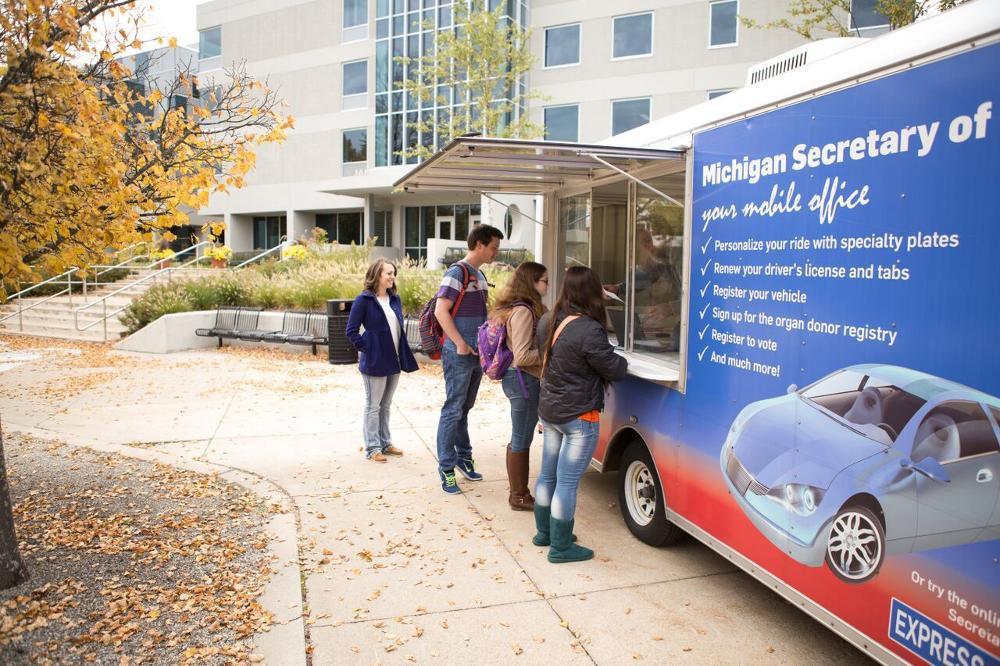Laker Line grant caught in congressional gridlock

GVL / Emily Frye Grand Valley students wait at the Kirkhof bus stop after classes on Aug. 31, 2016.
Sep 1, 2016
Grand Valley State University and the Rapid’s plans for the proposed Laker Line are at a gridlock due to political pressures in Washington, D.C.
While the proposed grant was submitted in the summer of 2015 and approved this February by the Federal Transit Administration (FTA) to cover the proposed $71 million transit line, the plans remain on hold until Congress passes a budget and appropriates the funds.
“With the ongoing political game of the presidential election in D.C., it is just a matter of time to find out things and wait to hear back from the FTA about funds, which could be next month or next spring, we just don’t know,” said Nick Monoyios.
Monoyios, the long-range planner for the Interurban Transit Partnership (the Rapid) and the project manager for the Laker Line, said the necessary funds for the project could potentially be split up into different years but depends on how the federal appropriations process proceeds.
Eighty percent of the proposed $71 million transit line will be covered by the FTA, while the Michigan Department of Transportation (MDOT) will fund the remaining 20 percent.
The Laker Line bus route is one of 10 similarly sized transit proposals across the U.S. to receive a grant from the FTA as part of President Barack Obama’s 2017 fiscal year budget.
Monoyios emphasized how the Laker Line Bus Rapid Transit (BRT) – which will travel to and from the Allendale to Pew campuses, with stops on the Medical Mile – will be faster than the current Route 50.
Also, he said, $14 million of the grant will go toward buying new vehicles for the Laker Line, which will include platform level boarding, Wi-Fi, three doors for quicker loading and unloading and other amenities in order to provide passengers a more comfortable ride.
“This route will have students moving from Kirkhof to downtown five minutes faster than the current routes,” he said. “We are also working closely with Grand Valley to reconstruct the circle drive outside of Kirkhof into a transit hub to maximize accessibility for transit and create a more comfortable experience for students.”
He also said adding the Laker Line as a transit route will allow GVSU to invest less money in creating additional parking spaces on the expanding Allendale and Pew campuses.
“As GVSU continues to grow, it is just smart urban planning,” he said. “The university would have no need to invest in parking lots and could instead use their lands in Allendale smarter and create an area not bombarded by parking spaces.”
Haley Bracken, a senior at GVSU who commutes from the Allendale and Pew campuses, likes the idea of the new transit line as it will give students a more comfortable experience when shuttling across the different campuses.
“There are so many people taking the 50 during the day and so many people are standing because there are not enough seats,” she said. “Having bigger and better buses will allow people to have a better experience and just improves your day to have a good bus experience.”
While the funding for the project remains on hold, Monoyios said that he and his team are confident about the outcome of the project.
Ultimately, they know it will happen he said, but it just matters when it will happen.
“We are very confident about the outcome of the project as it is one of the highest BRT projects in the country,” Monoyios said. “If we get half or all of it, it is the timeline we need to know so we can fine-tune our schedule to what Congress appropriates for the construction of the project.”
For more information about the Laker Line, visit www.lakerline.org.

























